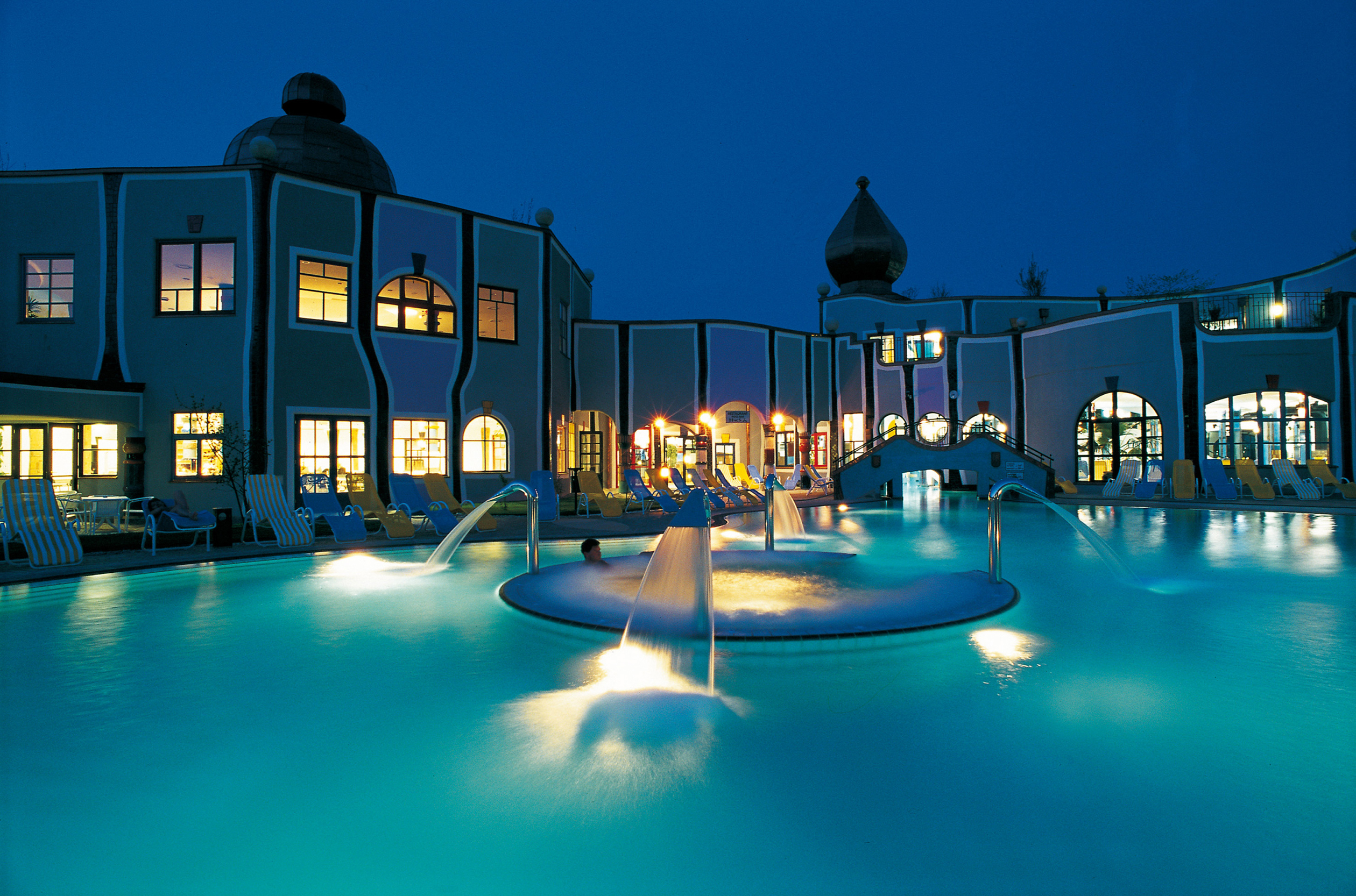
Surely the hobbit lives here.
That’s what I say to myself as I disembark from the provincial train that takes me from Graz, Austria’s second largest city and a vibrant university town, to Bad Blumau—a tiny village near Austria’s Hungarian border. The train pulls away, and I face a storybook panorama of rustic farmhouses, rolling hills, and checkerboards of farmland and blonde fields. To arrive here, I’ve chugged by vineyards, planted as perfect plaits into steep hills, and passed by fairytale hamlets, where cottages sport wooden shutters, artful decorative hearts (the Austrian symbol for welcome), and gingham curtains. Vast fields inhabited by colossal Lipizzaner horses, plump pumpkins mounded in wagons en route to market, and old men dressed in Loden green traditional attire enrich the scenery. But nothing prepares me for the awe I feel when I first glimpse Rogner’s Bad Blumau, the world’s largest piece of inhabitable art.
Like a city conjured from the pages of Dr. Seuss, Rogner Bad Blumau undulates and rambles just behind a traditional village. Suggesting a Space Age castle, it beckons atop a hill: a complex of curvy-lined, onion-domed structures, sprinkled with more than two thousand erratically shaped windows—not one of them like the other. A warren, of multi-story buildings, glittering with gold highlights, block-painted in earth-tone hues (from sky-blue to orange), adorned with fantastical columns, roof-top gardens and terraces, the resort also has underground passageways with bewitching cobbled floors, which feel like walking through tubes. Tying it all together, 11 indoor and outdoor pools, Jacuzzis, plentiful decks, myriad saunas, a spa, and abundant bridges form the heartbeat of this living piece of art, which sits atop two, naturally heated mineral springs.
“Bads” or bath towns have long been an attraction for wellness seeking travelers to Styria, an Austrian region located south of Vienna. A mystical topography, with fresh mountain air and verdant farmland, Styria is also known for its produce and culinary tourism—from wine to the thick, emerald-green pumpkin seed oil the locals use as a condiment. Austrians, like many Europeans, historically spent time in this area for the Kur—an annual curative ritual which generally entails mineral-rich thermal waters, spa treatments, a connection with nature, meditation (or another mind/spirit element), and relaxation. But Rogner Bad Blumau took this sometimes-rustic experience up a notch when it was built in 1968 by visionary developer Robert Rogner. Recognizing a mystical pull to the terrain, he commissioned Friedensreich Hundertwasser, one of Austria’s (and the world’s) most entrancing eccentric artists, to build a “bath” resort worthy of the property. Hundertwasser, whose name, ironically, translates to “hundred waters,” (best known for his paintings and his Gaudi-like architectural projects), was reluctant—until he visited Styria and felt the power of Bad Blumau.
Austrians, like many Europeans, historically spent time in this area for the Kur—an annual curative ritual which generally entails mineral-rich thermal waters, spa treatments, a connection with nature, meditation, and relaxation…
To whit, a hobbit house—or better, a hobbit village—was born. Just as the exterior evokes the fantastical, interior common rooms and guest rooms contain furniture and artwork specifically designed by Hundertwasser for the property. Guests staying at Rogner Bad Blumau become part of an installation art piece, even as they float in the warm pools, hike the paths that wind through the property, or sit down to a farm-to-table meal in one of the restaurants. A stunning place, which is also healthful, the complex has a spa that crowns an otherworldly tower. It offers indigenous Austrian treatments, performed with salves made from local herbs, as well as Tibetan and Ayurvedic rituals. The silky water ranges in temperature, and vaunts minerals known to aid in ameliorating ailments from arthritis to eczema.
I depart Rogner Bad Blumau without seeing a hobbit—or any other elfin creature. But days pondering Hundertwasser’s ability to meld art with nature, hours of splashing in hot springs, and daily bike rides up an Austrian mountain do result in something I call the hobbit effect: I leave the place feeling renewed—and . . . spritely.
What to Drink: Visit Styria in September and try sturm, a wine drunk in the autumn while still in the fermented stage.
What to eat: Styrian apples, runner beans, and pork.
Urbane Stay: Spend a few days in vibrant Graz, awash with museums. Steiermark.com
Take the Train: Traveling around Europe, consider a three-country Eurail train pass. Eurail.com
What to Buy: Take home some pumpkin-seed oil made by local farmers and found at markets all over Styria. Use it on salads—or as you would any condiment.
Becca Hensley
Becca Hensley is Editor at Large for Insider's Guide to Spas. Based in Austin, she writes regularly about travel and spas. She believes a good story draws you in like laughter in a crowded room, and challenges you to do it justice. Her work appears regularly in Austin Monthly, Travel Channel, Toronto Star and National Geographic Traveler.